Investigation of the Beam Quality of a Compact Non-Chain Pulsed DF Laser with a Confocal Positive Branch Unstable Resonator
Abstract
:1. Introduction
2. Theoretical Calculation of the Laser Beam Divergence
3. Experimental Arrangement
4. Experimental Results and Their Discussions
- (1)
- The light beam is regarded as a parallel light when calculating the theoretical divergence angle of the confocal unstable resonator. However, the actual output beam of the unstable resonator should be a near-parallel light with a certain geometric divergence angle, which is caused by factors such as cavity mirror spacing, curvature error, and mirror tilt;
- (2)
- The straight-edge diffraction caused by electrode diffraction will also increase the actual divergence of the laser beam;
- (3)
- The thermal denaturation of the output and convex mirrors increases the size of the divergence angle.
5. Conclusions
Author Contributions
Funding
Institutional Review Board Statement
Informed Consent Statement
Data Availability Statement
Conflicts of Interest
References
- Belevtsev, A.A.; Firsov, K.N.; Kazantsev, S.Y.; Kononov, I.G.; Podlesnykh, S.V. Self-sustained volume discharge in mixtures of SF6 with hydrocarbons, hydrogen and deuterium for non-chain HF(DF) lasers. J. Phys. D Appl. Phys. Europhys. J. 2018, 51, 384003. [Google Scholar] [CrossRef]
- Pan, Q.; Xie, J.; Wang, C.; Shao, C.; Shao, M.; Chen, F.; Guo, J. Non-chain pulsed DF laser with an average power of the order of 100 W. Appl. Phys. B Lasers Opt. 2016, 122, 200. [Google Scholar] [CrossRef]
- Yang, N.; Li, G.; Zhao, Y.; Zhang, J.; Wen, X. Investigation on pulsed discharge mode in SF6-C2H6 mixtures. Plasma Sci. Technol. 2020, 22, 109–116. [Google Scholar] [CrossRef]
- Tao, M.; Shen, Y.; Zhu, F.; Huang, C.; Ma, L.; Chen, H.; Luan, K.; Huang, K.; Feng, G.; Ye, X. Pulse energy sustainability of a burst mode closed-cycle pulsed HF chemical laser. Laser Phys. 2019, 29, 35001. [Google Scholar] [CrossRef]
- Driscoll, R.J.; Tregay, G.W. Flow field experiments on a DF chemical laser. AIAA J. 2015, 21, 241–246. [Google Scholar] [CrossRef]
- Apollonov, V.V. High energy HF (DF) lasers. J. Phys. Res. Appl. 2018, 1, 1–16. [Google Scholar]
- Apollonov, V.V.; Kazantsev, S.Y. High-Energy HF (DF) Lasers Based on Non-Chain Chemical Reaction. J. Pure Appl. Phys. 2020, 2, 1–13. [Google Scholar]
- Altmann, J.; Pokrowsky, P. Sulfur dioxide absorption at DF laser wavelengths. Appl. Opt. 1980, 19, 3449–3452. [Google Scholar] [CrossRef] [PubMed]
- Pokrowsky, P. Absorption of H2S at DF laser wavelengths. Appl. Opt. 1983, 22, 2221–2223. [Google Scholar] [CrossRef]
- Agroskin, V.Y.; Bravy, B.G.; Chernyshev, Y.A. Aerosol sounding with a lidar system based on a DF laser. Appl. Phys. B 2005, 81, 1149–1154. [Google Scholar] [CrossRef]
- Vasilev, B.I.; Mannoun, O.M. IR differential-absorption lidars for ecological monitoring of the environment. Quantum Electron. 2006, 36, 801–820. [Google Scholar] [CrossRef]
- Wilson, G.; Graves, B.R.; Patterson, S.P.; Wank, R.H. Deuterium fluoride laser technology and demonstrators. In Proceedings of the SPIE Laser Technologies for Defense and Security, Orlando, FL, USA, 10 September 2004; Volume 5414, pp. 41–51. [Google Scholar]
- Ruan, P.; Pan, Q.; Alekseev, E.E.; Kazantsev, S.Y.; Mashkovtseva, L.S.; Mironov, Y.B.; Podlesnikh, S.V. Performance improvement of a Fe2+:ZnSe laser pumped by non-chain pulsed HF laser. Optik 2021, 242, 167005. [Google Scholar] [CrossRef]
- Velikanov, S.D.; Elutin, A.S.; Pegoev, I.N.; Sin’kov, S.N.; Frolov, Y.N. Measurement of the coefficients of reflection of DF laser radiation from topographic retroreflectors. Quantum Electron. 1998, 28, 173–174. [Google Scholar] [CrossRef]
- Mirov, S.B.; Moskalev, I.S.; Vasilyev, S.; Smolski, V.; Fedorov, V.V.; Martyshkin, D.; Peppers, J.; Mirov, M.; Dergachev, A.; Gapontsev, V. Frontiers of mid-IR lasers based on transition metal doped chalcogenides. IEEE J. Sel. Top. Quantum Electron. 2018, 24, 1601829. [Google Scholar] [CrossRef]
- Firsov, K.N.; Gavrishchuk, E.M.; Ikonnikov, V.B.; Kazantsev, S.Y.; Kononov, I.G.; Kotereva, T.V.; Savin, D.V.; Timofeeva, N.A. Room-temperature laser on a ZnSe:Fe2+ polycrystal with undoped faces, excited by an electrodischarge HF laser. Laser Phys. Lett. 2016, 13, 55002. [Google Scholar] [CrossRef]
- Pan, Q.; Xie, J.; Chen, F.; Zhang, K.; Yu, D.; He, Y.; Sun, J. Transversal parasitic oscillation suppression in high gain pulsed Fe2+:ZnSe laser at room temperature. Opt. Laser Technol. 2020, 127, 106151. [Google Scholar] [CrossRef]
- Alekseev, E.E.; Kazantsev, S.Y.; Podlesnikh, S.V. Potential of crystals with a nonuniform doping profile for a Fe2+:ZnSe laser. Opt. Mater. Express 2020, 10, 2075–2084. [Google Scholar] [CrossRef]
- Apollonov, V.V.; Kazantsev, S.Y.; Saifulin, A.V.; Firsov, K.N. Discharge characteristics in a nonchain HF(DF) laser. Quantum Electron. 2000, 30, 483–485. [Google Scholar] [CrossRef]
- Tarasenko, V.F.; Panchenko, A.N. Efficient discharge-pumped non-chain HF and DF lasers. In Proceedings of the SPIE Laser Beam Control and Applications, San Jose, CA, USA, 21–26 January 2006; Volume 6101, pp. 61011–61019. [Google Scholar]
- Harris, M.R.; Morris, A.V.; Gorton, E.K. A closed-cycle, 1 kHz pulse repetition frequency, HF (DF) laser. In Proceedings of the SPIE Gas and Chemical Lasers and Intense Beam Applications, San Jose, CA, USA, 12 May 1998; Volume 3268, pp. 247–251. [Google Scholar]
- Velikanov, S.D.; Evdokimov, P.A.; Zapol’Sky, A.F.; Kodola, B.E.; Sokolov, D.V.; Cernopyatov, V.Y.; Yakovlev, E.D. Pulse periodic HF (DF)-laser of atmospheric pressure with pulse repetition rate up to 2200 Hz. In Proceedings of the SPIE XVII International Symposium on Gas Flow, Chemical Lasers, and High-Power Lasers, Lisboa, Portugal, 17 April 2009; Volume 7131, pp. 228–234. [Google Scholar]
- Aksenov, Y.N.; Borisov, V.P.; Burtsev, V.V.; Velikanov, S.D.; Voronov, S.L.V.; Voronin, V.V.; Zapol’skii, A.F.; Kirillov, G.A.; Kovalenko, O.I.; Lazarenko, V.I.; et al. A 400-W repetitively pulsed DF laser. Quantum Electron. 2001, 31, 290–292. [Google Scholar] [CrossRef]
- Huang, C.; Huang, K.; Ma, L.; Zhu, F.; Yi, A.-P. Hundred-Hertz nonchain HF laser with long operation period based on initiated discharge. Opt. Precis. Eng. 2019, 27, 1060–1068. [Google Scholar] [CrossRef]
- Bulaev, V.D.; Kulikov, V.V.; Petin, V.N.; Yugov, V.I. Experimental study of a nonchain HF laser on heavy hydrocarbons. Quantum Electron. 2001, 31, 218–220. [Google Scholar] [CrossRef]
- Apollonov, V.V.; Belevtsev, A.A.; Firsov, K.N.; Kazantsev, S.Y.; Saifulin, A.V. Advanced studies on powerful wide-aperture non-chain HF(DF) lasers with a self-sustained volume discharge to initiate chemical reaction. In Proceedings of the SPIE XIV International Symposium on Gas Flow, Chemical Lasers, and High-Power Lasers, Wroclow, Poland, 10 November 2003; Volume 5120, pp. 529–541. [Google Scholar]
- Brunet, H.; Mabru, M.; Voignier, F. High energy-high average power pulsed HF/DF chemical laser. In Proceedings of the SPIE Gas Flow and Chemical Lasers: Tenth International Symposium, Friedrichshafen, Germany, 31 March 1995; Volume 2502, pp. 388–392. [Google Scholar]
- Rensch, D.B.; Chester, A.N. Iterative diffraction calculations of transverse mode distributions in confocal unstable laser resonators. Appl Opt. 1973, 12, 997–1010. [Google Scholar] [CrossRef] [PubMed]
- Born, M.; Wolf, E. Principles of Optics, 6th ed.; Pergamon Press: Oxford, UK, 1980; pp. 416–418. [Google Scholar]
- Tan, G.; Xie, J.; Pan, Q.; Shao, C.; Zhang, C.; Ruan, P.; Guo, J. Design and Experimental Investigation on Unstable Resonator for Non-Chain Pulsed DF Laser. Chin. J. Lasers 2014, 41, 102004. [Google Scholar]

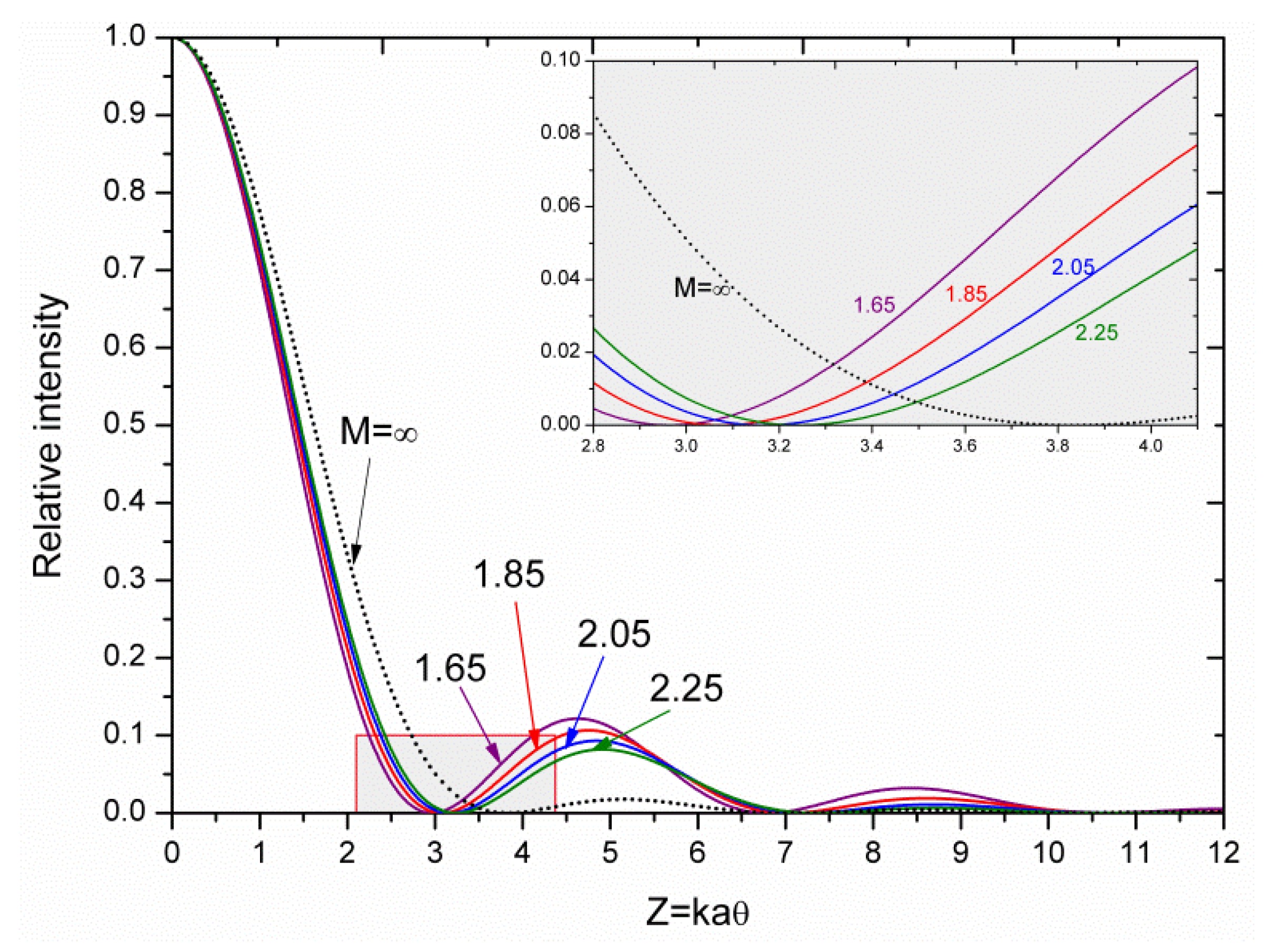
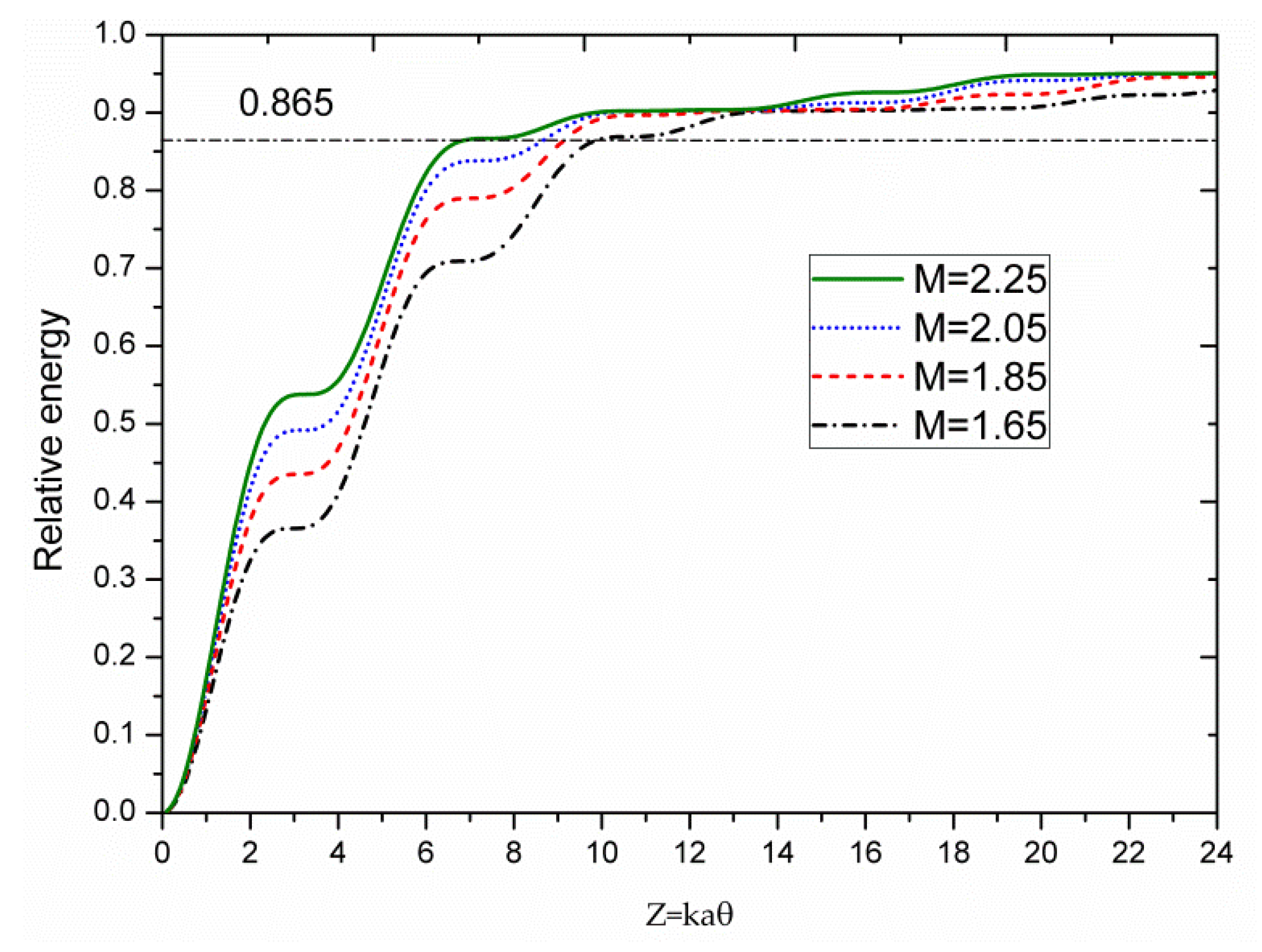
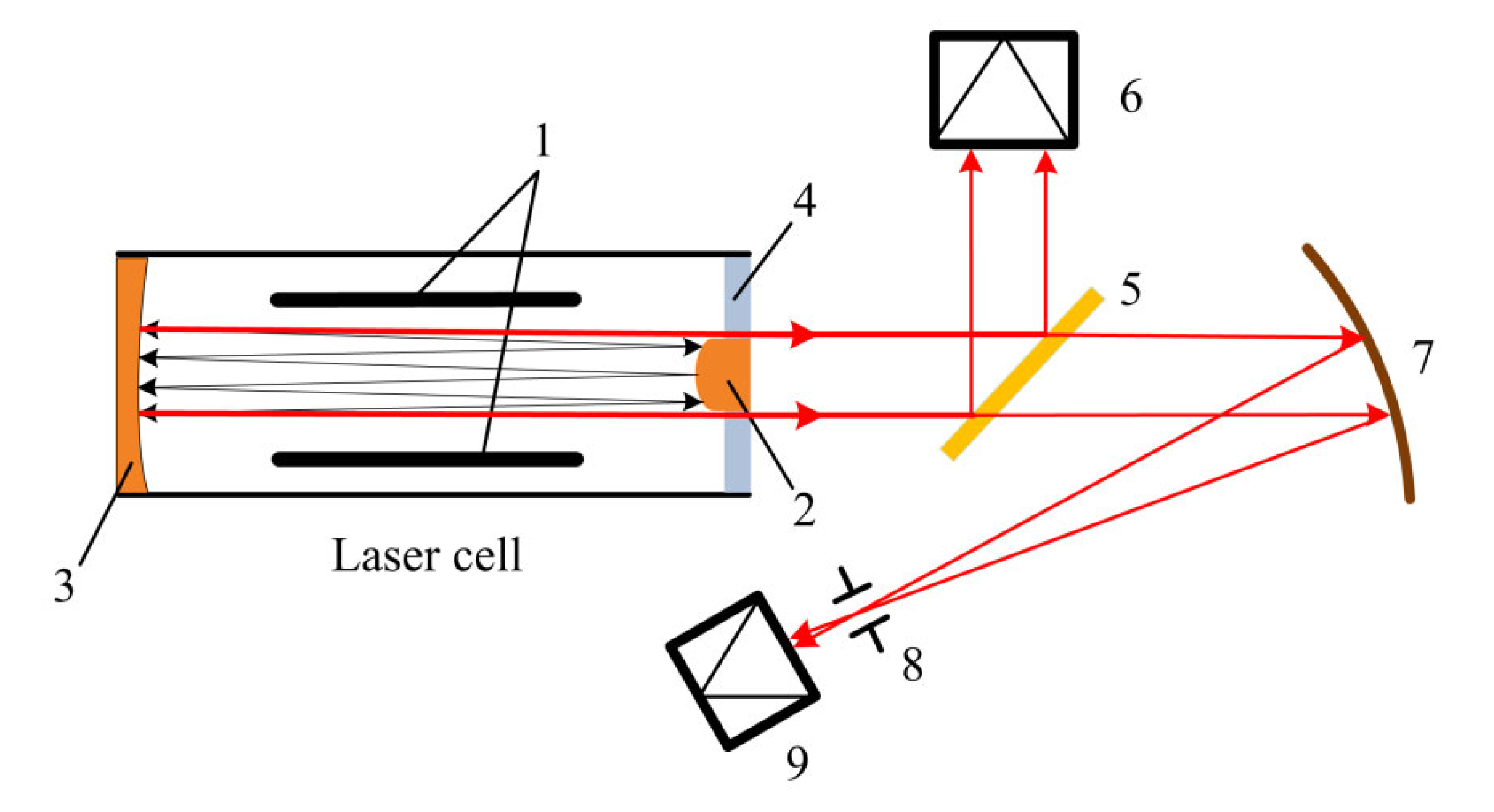
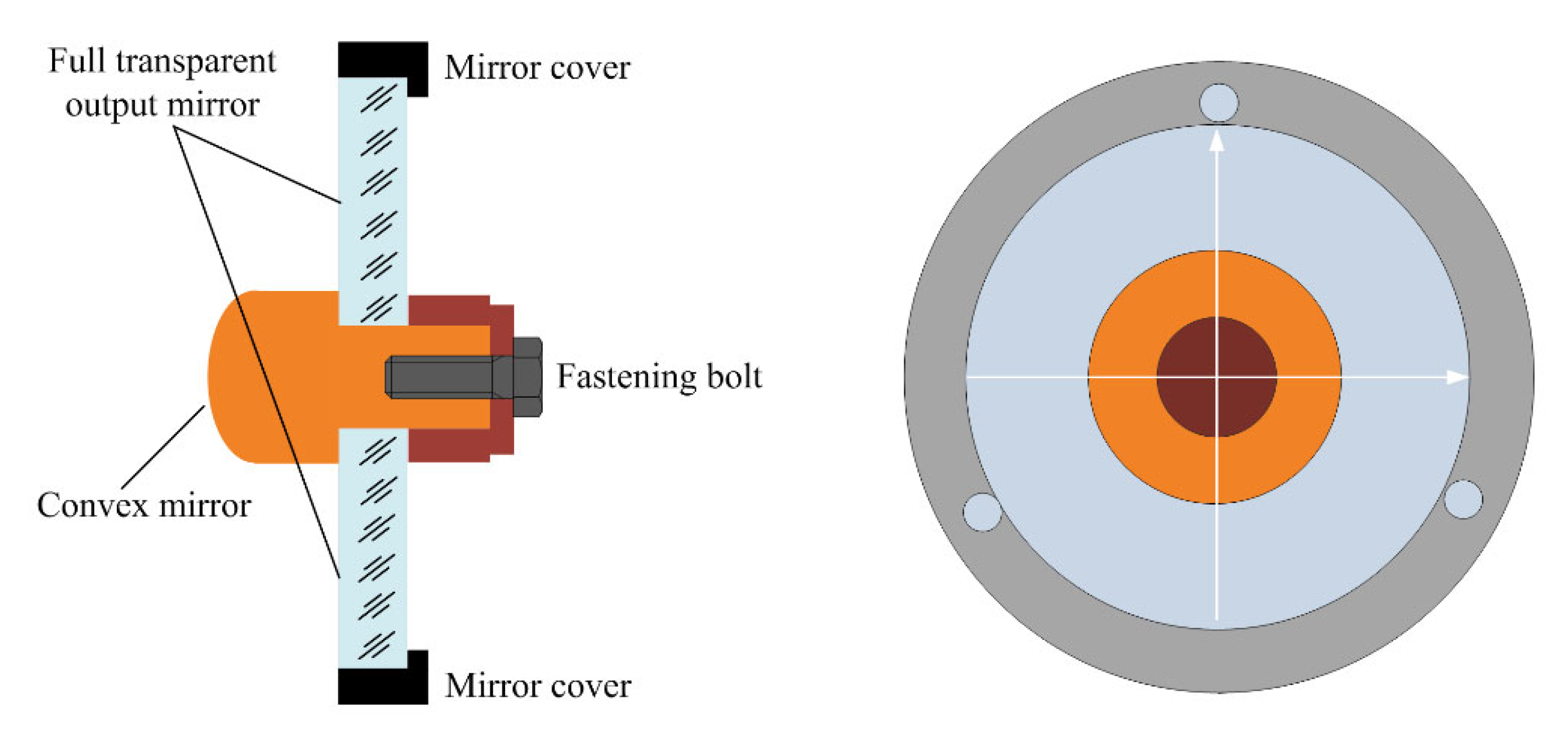
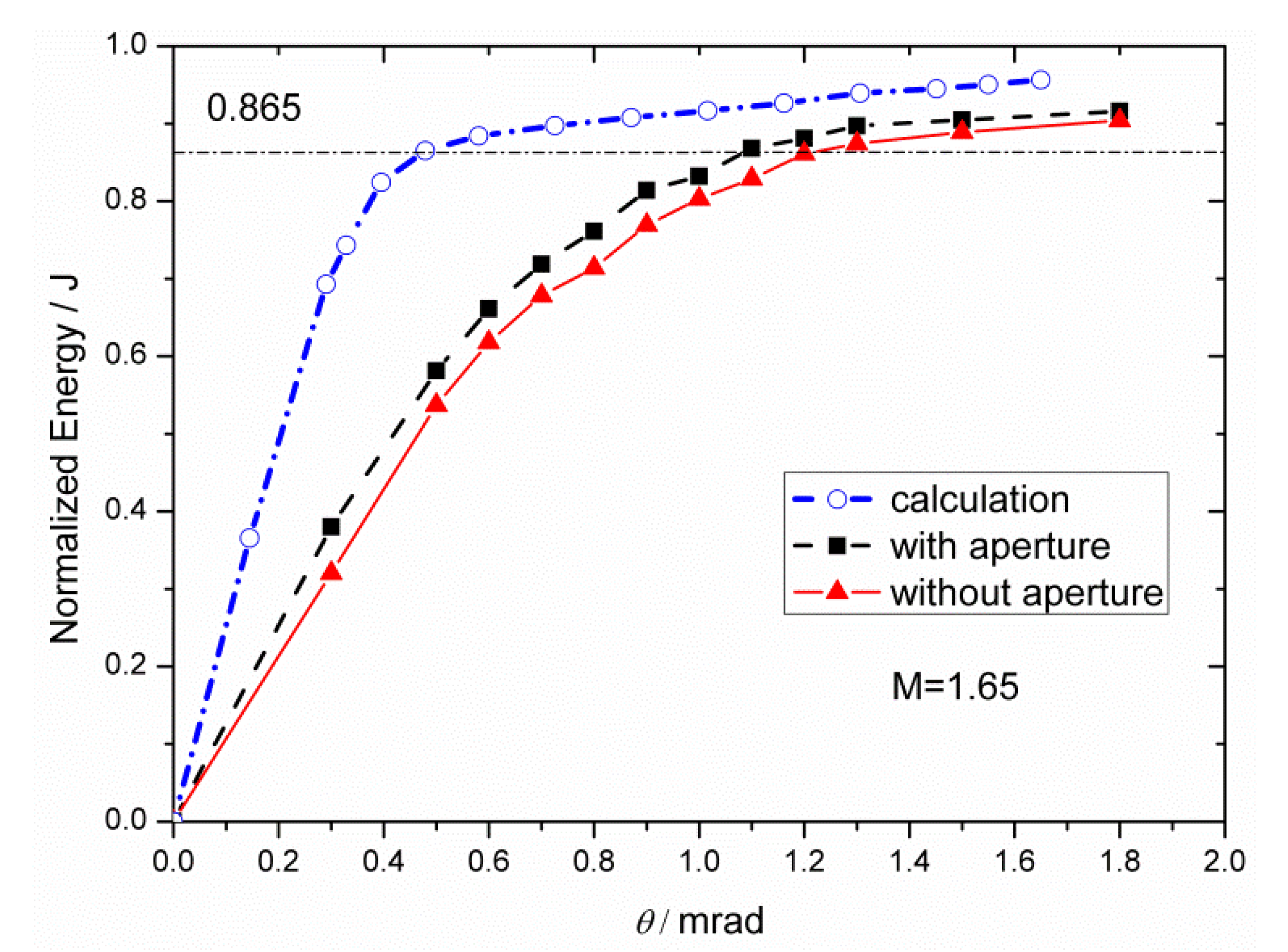

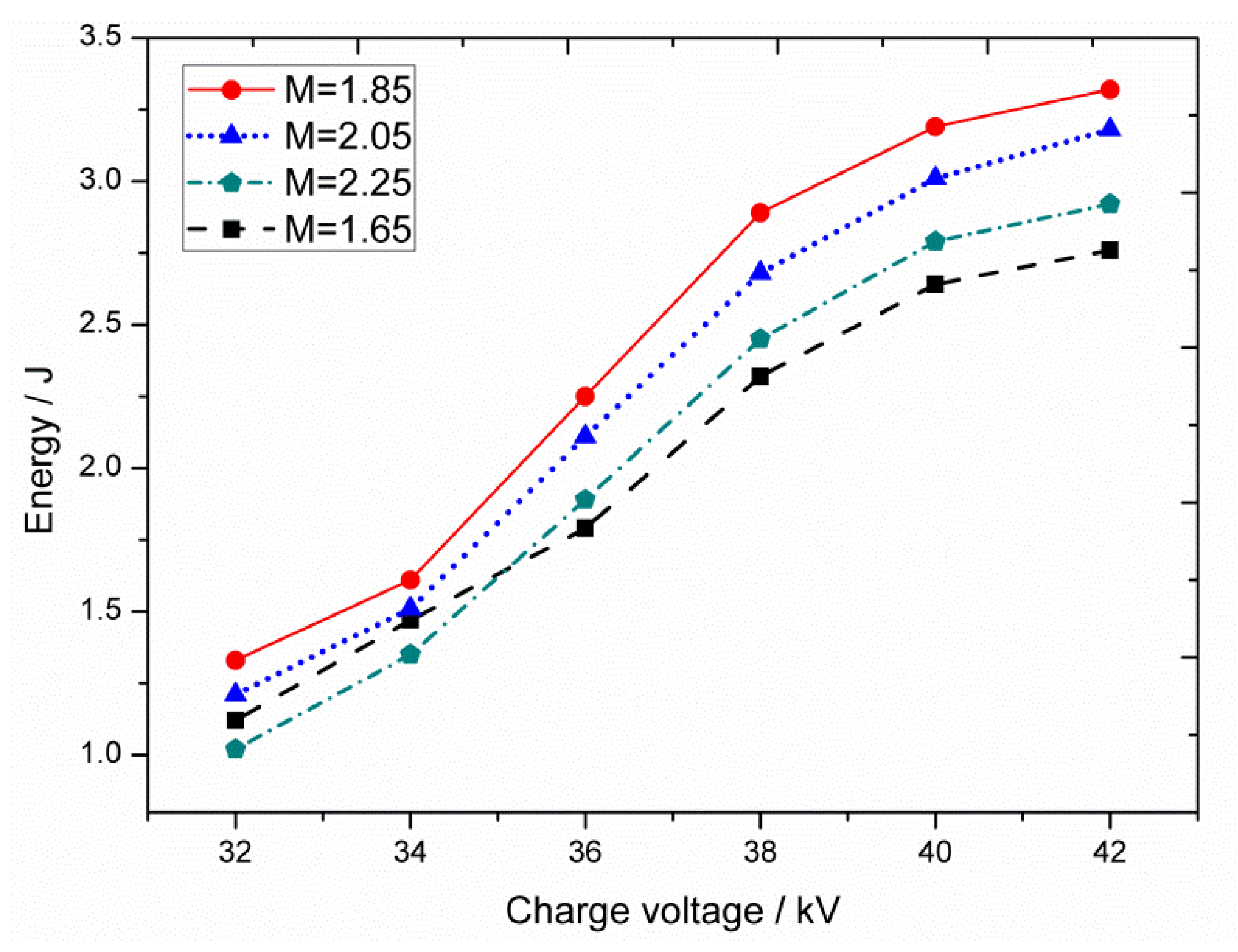

| M | C | R1/mm | R2/mm | D1/mm | D2/mm | L/mm |
|---|---|---|---|---|---|---|
| 1.65 | 0.633 | −6501.5 | 10,727.5 | 30.2 | 50 | 2113 |
| 1.85 | 0.708 | −4971.9 | 9197.8 | 26.9 | 50 | 2113 |
| 2.05 | 0.762 | −4024.8 | 8250.8 | 24.2 | 50 | 2113 |
| 2.25 | 0.802 | −3380.8 | 7606.8 | 22.2 | 50 | 2113 |
| M | Z | θ/mrad |
|---|---|---|
| 1.65 | 9.9 | 0.479 |
| 1.85 | 9.2 | 0.445 |
| 2.05 | 8.7 | 0.421 |
| 2.25 | 7.0 | 0.339 |
| Type | M | θcal/mrad | θexp/mrad | β = θexp/θcal | E/J | ρ/(mJ/m2) |
|---|---|---|---|---|---|---|
| stable | — | 0.190 | 7.15 | 37.63 | 3.65 | 0.91 |
| unstable | 1.65 | 0.479 | 1.08 | 2.25 | 2.76 | 30.1 |
| unstable | 1.85 | 0.445 | 0.97 | 2.18 | 3.32 | 45.9 |
| unstable | 2.05 | 0.421 | 0.86 | 2.04 | 3.18 | 54.7 |
| unstable | 2.25 | 0.339 | 0.66 | 1.95 | 2.93 | 82.8 |
Disclaimer/Publisher’s Note: The statements, opinions and data contained in all publications are solely those of the individual author(s) and contributor(s) and not of MDPI and/or the editor(s). MDPI and/or the editor(s) disclaim responsibility for any injury to people or property resulting from any ideas, methods, instructions or products referred to in the content. |
© 2023 by the authors. Licensee MDPI, Basel, Switzerland. This article is an open access article distributed under the terms and conditions of the Creative Commons Attribution (CC BY) license (https://creativecommons.org/licenses/by/4.0/).
Share and Cite
Zhang, L.; Ruan, P.; Chen, F.; Shao, C.; Pan, Q.; Guo, J. Investigation of the Beam Quality of a Compact Non-Chain Pulsed DF Laser with a Confocal Positive Branch Unstable Resonator. Appl. Sci. 2023, 13, 3229. https://doi.org/10.3390/app13053229
Zhang L, Ruan P, Chen F, Shao C, Pan Q, Guo J. Investigation of the Beam Quality of a Compact Non-Chain Pulsed DF Laser with a Confocal Positive Branch Unstable Resonator. Applied Sciences. 2023; 13(5):3229. https://doi.org/10.3390/app13053229
Chicago/Turabian StyleZhang, Laiming, Peng Ruan, Fei Chen, Chunlei Shao, Qikun Pan, and Jin Guo. 2023. "Investigation of the Beam Quality of a Compact Non-Chain Pulsed DF Laser with a Confocal Positive Branch Unstable Resonator" Applied Sciences 13, no. 5: 3229. https://doi.org/10.3390/app13053229
APA StyleZhang, L., Ruan, P., Chen, F., Shao, C., Pan, Q., & Guo, J. (2023). Investigation of the Beam Quality of a Compact Non-Chain Pulsed DF Laser with a Confocal Positive Branch Unstable Resonator. Applied Sciences, 13(5), 3229. https://doi.org/10.3390/app13053229





